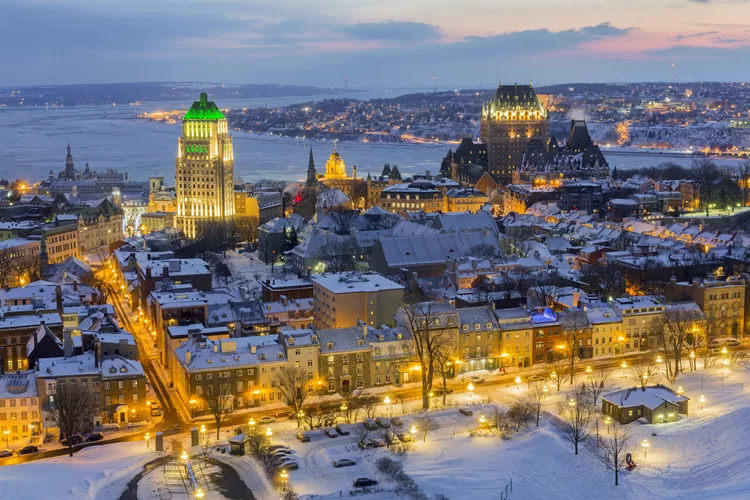Summary of Quebec City Highlights

Situated strategically along the Saint Lawrence River, a three-hour journey east of Montreal, Quebec City stands out as an exceptionally distinctive city in North America.
While San Francisco boasts its wharf and winding hills and New Orleans is renowned for its French Quarter and vibrant jazz, Quebec City offers a strikingly European atmosphere with its cobbled streets, architectural elegance, and a predominantly French-speaking populace.
Moreover, Quebec City’s appeal lies not in artificial imitation, but rather in its authentic history and culture. Establishing itself as the capital of New France in 1608, it has preserved much of its original character, architecture, and ambiance over the centuries.
1. Breakneck Stairs to Old Town

The Breakneck Stairs provide a renowned descent from the Dufferin Terrace situated outside the Chateau Frontenac into the lower town and is among the most photographed locales within Quebec City.
The stairs are constructed of wood and are quite steep; however, their name may evoke a sense of intimidation that is unwarranted. A handrail is available, thus allowing a diverse range of individuals to navigate them with ease.
Adjacent to the Breakneck Stairs is the Funicular, which has been in operation since 1879, offering a more comfortable transition into the lower regions of Quebec City (or an ascent to Upper Town).
2. Gate St. Louis

Porte St. Louis represents one of three gates that were once designed to fend off attackers, providing beautiful entrances into Old Quebec City. These stone gates are part of the fortifications surrounding the Old Town. Visitors can stroll around the entire structure, with several opportunities to traverse across the top of the wall and gates.
3. Petit Champlain

Petit Champlain is an enchanting neighborhood in the historic section of Quebec City, replete with restaurants, outdoor patios, art galleries, and a captivating charm that is distinctly different from the rest of Canada; yet, it remains wholly authentic, serving as a delightful nod to the nation’s French heritage, which thrives in the region.
The district is named in honor of Samuel de Champlain, the founder of Quebec City in 1608. Additionally, the renowned Breakneck Stairs, which connect Upper and Lower Quebec, are part of Petit Champlain.
4. Chateau Frontenac

The Chateau Frontenac is part of a collection of hotels established by the Canadian Railway in the 19th century to accommodate travelers transiting across the country. Fortunately, many of these historic establishments continue to operate today under the Fairmont Hotels & Resorts banner, including the Banff Springs Hotel, Chateau Lake Louise, the Royal York in Toronto, and Manoir Richelieu in eastern Quebec.
5. Quebec Winter Carnival

The Quebec Winter Carnival is recognized as the largest winter festival globally, having preserved its charm due in large part to its commitment to its origins as a family-oriented festival that celebrates the cold, snowy winters of Quebec. It encapsulates the lives of Quebeckers in a manner that is accessible to outsiders. Bonhomme, the carnival’s friendly and whimsical mascot, has remained a beloved figure throughout the event’s rich history.
The tradition of the Quebec Winter Carnival originated with the settlers of New France—now Quebec—who celebrated boisterously just before Lent by indulging in food, drink, and festive activities.
6. Ice Canoe Race

One of the most thrilling activities at the Quebec Winter Carnival is the ice canoe race. Daring participants don wetsuits and engage in unusual modes of transport as they traverse the Saint Lawrence River from Quebec City to Levis.
Previously a legitimate means of navigating the St. Lawrence River, ice canoeing has evolved into a competitive sport where several courageous athletes maneuver their canoes across an often uneven water surface, alternating between carrying and paddling their craft. The excitement lies in observing each team as they strategically determine their optimal route amid the continually shifting sub-zero landscape.
7. Cruise Port

Quebec City serves as a port for a variety of cruises navigating the Saint Lawrence Seaway toward the Maritimes and Newfoundland or along the North Atlantic coast toward New York.
Notably, the fall foliage cruise between Quebec City and New York is acclaimed as one of the most picturesque journeys in North America.
Numerous cruise lines, including Adventure Canada, Royal Caribbean, Norwegian, and Holland, operate departures from this iconic city.





